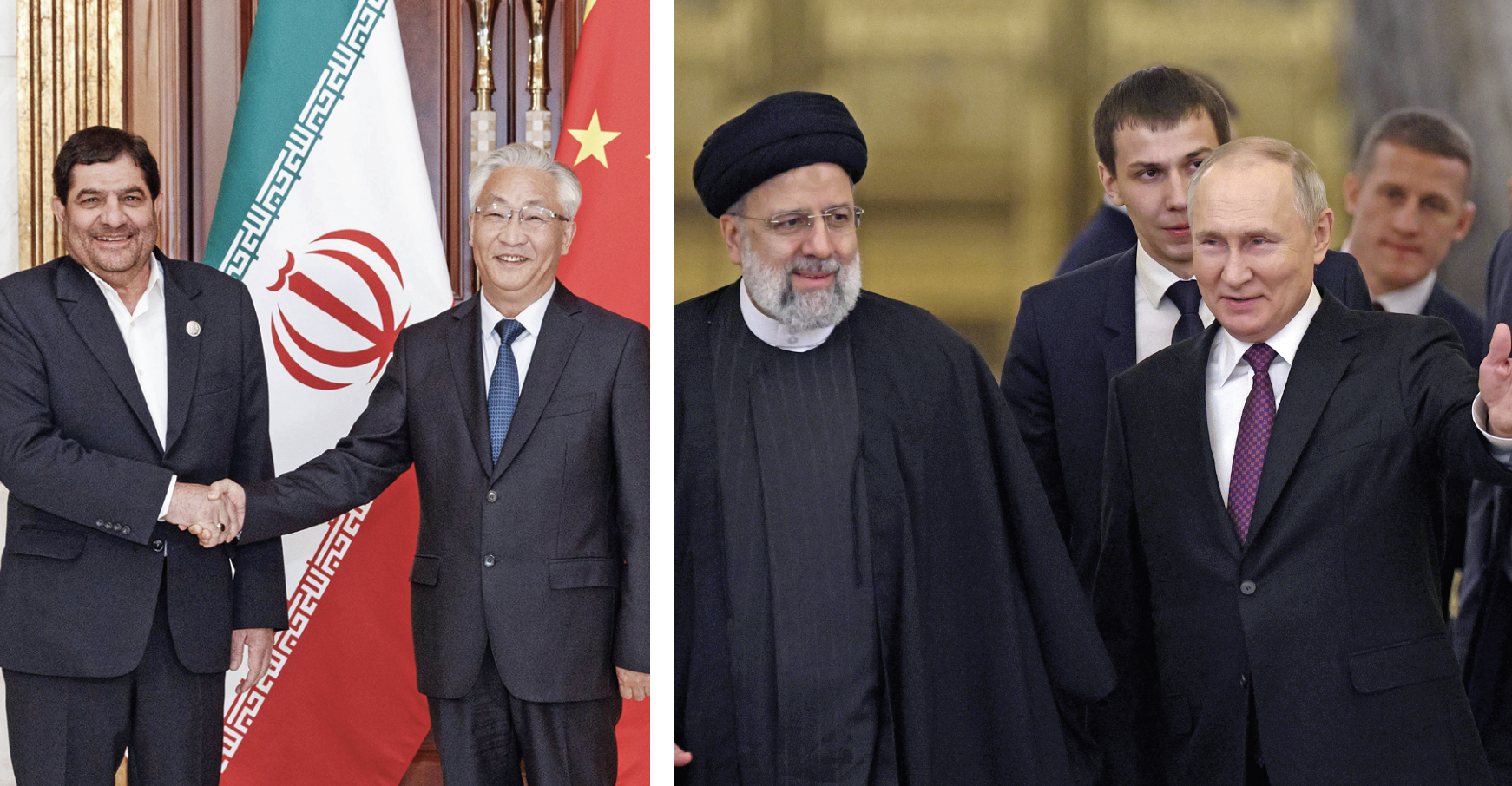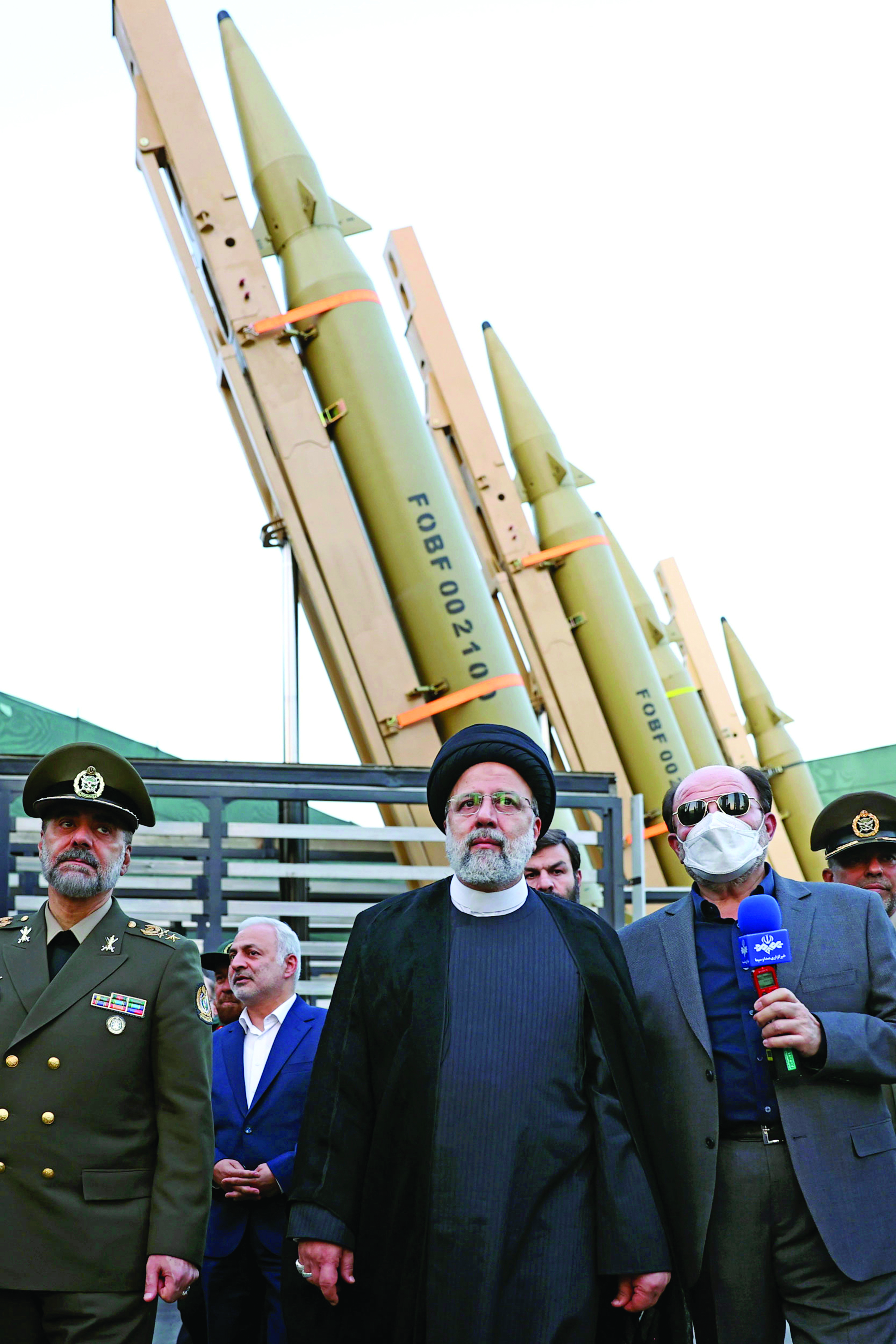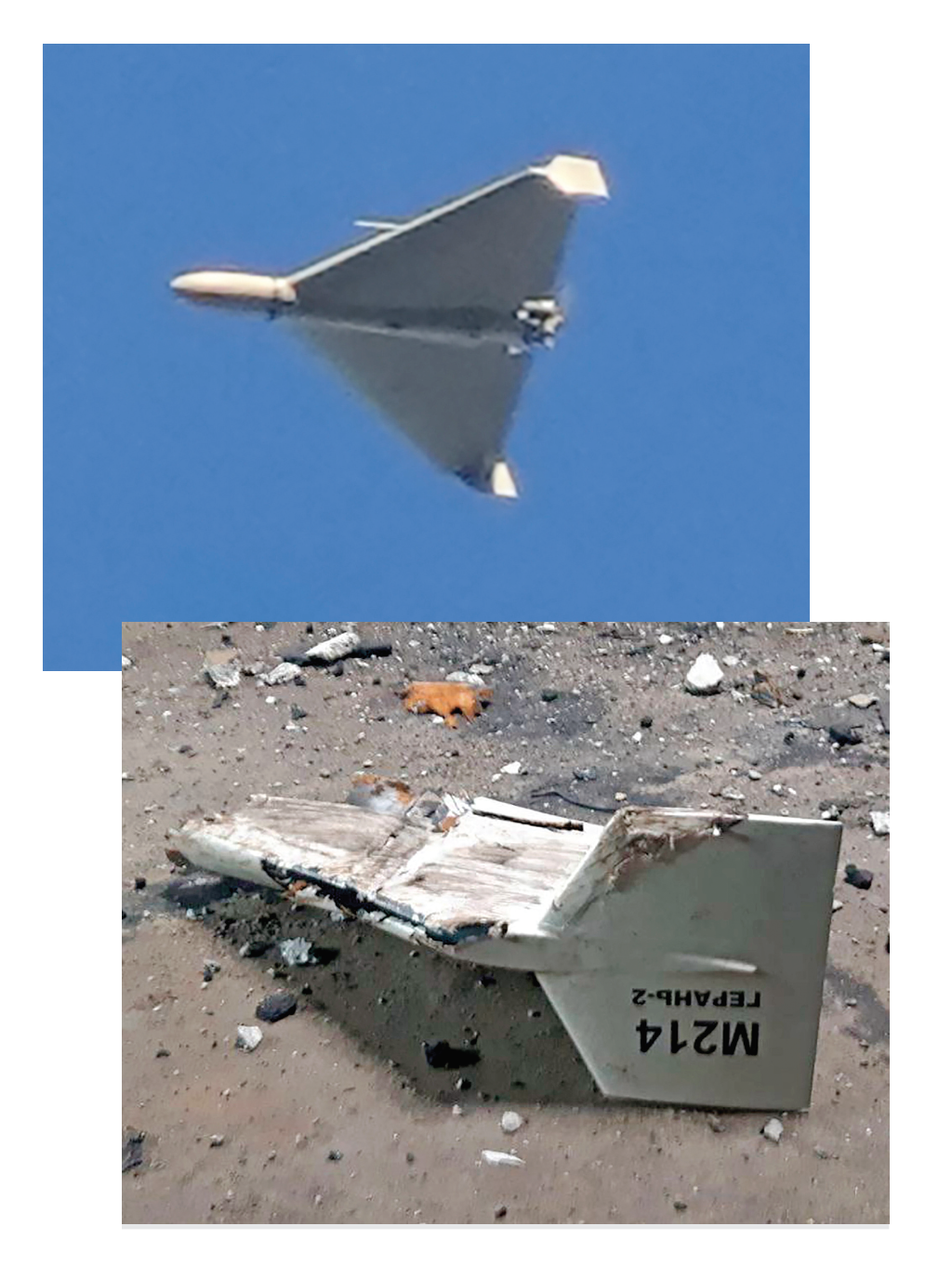
Arsenal of autocracy
Michael Lucchese
As war rages in Israel and Ukraine, Iran is supplying both Hamas and Russia with weaponry, especially combat drones. And for decades now, it has armed Islamist militants across the Middle East that target American troops, including at least 45 service members injured by 38 drone attacks since Oct. 17.
If the United States wants to reestablish global security and end the conflicts in these regions, it will need to understand the military connections among adversaries and work to subvert them.
THE RED-GREEN ALLIANCE AGAINST THE WEST
In recent weeks, especially since Hamas launched its sickening assault on Israel, Iran has ramped up its public displays of affection toward Russia, inviting leaders from Moscow into the heart of the country. In September, for instance, Russian Defense Minister Sergei Shoigu traveled to Tehran to inspect production lines for unmanned aerial vehicles and declared that “Russian-Iranian interaction is reaching a new level.” Russian Foreign Minister Sergey Lavrov recently journeyed there to strengthen ties between the regimes. All this is happening, of course, while Vladimir Putin’s regime insists that Israel and the U.S. are really to blame for Hamas’s horrific attacks.

Despite these obviously growing ties between Iran, Hamas, and Russia, some in the U.S. media still refuse to see the link between the wars in Israel and Ukraine. They insist the Iranian regime’s deeply sectarian ideology has little appeal for anyone besides radicalized Shiite Muslims. Sunni extremists, such as the members of Hamas, certainly do not affirm the Shiite Iranian Revolution’s central theological tenets. And, to be sure, Putin has often positioned himself as a bulwark for Europe against Islamist threats. Somehow, though, these groups still find ways to work together.
What unites these incongruent powers is their abiding anti-American sentiment. Notwithstanding their apparent ideological differences, Iran, Hamas, and Russia all share a deep antipathy for the West in general and the U.S. specifically. Iran is essentially rallying the globe’s despots and tyrants around what Edmund Burke might have called an “armed doctrine” of anti-Americanism.
Western leaders would do well to imitate the moral clarity Edmund Burke possessed about the threats to his country’s security. In 1796, the Anglo-Irish statesman wrote a series of essays titled Letters on a Regicide Peace. He warned that a premature ceasefire with the revolutionary French Republic would be a disaster for Great Britain because the Jacobin revolutionists would nonetheless continue to work for the “subversion” of British power. In one of his most famous lines, Burke declared that it was not so much with a country but rather “it is with an armed doctrine that we are at war.”
Iran’s efforts to support both Hamas and Russia are really an attempt to arm the doctrine of anti-Americanism. They seek to degrade American political, economic, and cultural primacy in the world. There is no middle ground between American security and Iranian ambitions — just as Burke believed Britain could not negotiate with the French Revolution, America cannot negotiate with the Iranian Revolution. The regime in Tehran wants to upend the world order created after World War II and secured through victory in the Cold War. The U.S. cannot allow that to happen.

One of the most important ways Iran is arming its anti-American partners is by supplying them with battlefield drones. Islamist militias in southern Syria recently used drones to attack American troops at their base. Although it may be difficult to track exactly who supplied the terrorist cells with the drones, it is certain they are proxies of the Islamic Republic of Iran. The training and supplies provided to these terrorists by Iran are clear indications that their goal is not only to hurt American interests but to kill American troops as well. Sadly, this attack is just one example of Iran’s strategy of arming America’s enemies to redefine the future of war. And it demonstrates that drones are becoming essential to modern warfare.
Belligerents all over the globe are using UAVs to attack their opponents remotely, from sophisticated loitering munitions that hover above targets before delivering explosives via a warhead to inexpensive commercial drones. These weapons have been adopted so readily in part because they provide a cheap, more precise alternative to conventional artillery fire.
Terrorist groups increasingly use drones to gain asymmetric advantages against Israel and the U.S. Hamas, for instance, deployed drones during its Oct. 7 assault on innocent Israeli civilians. The death toll was so high in part because Hamas used these drones in combined arms attacks alongside other Iranian-made weapons and munitions, such as AZ111 mortar fuses and M112 demolition charges.
Russia has also been making extensive use of drones in its brutal war with Ukraine. Its UAVs frequently hit Ukrainian cities, leaving dozens of civilians dead and hundreds wounded. Many of these drones are produced by Iran and are only one example of the arms Russia receives from the Islamic Republic. The Russian military also accepts regular shipments of Iranian artillery shells via the Caspian Sea. And there are tens of thousands of amputees in Ukraine today, more than the United Kingdom had at the height of World War II, in no small part because Iran is supplying Russia with many of the same deadly explosives it gives Hamas.
It should be clear, then, that Iran is a core node of a new axis of military power, more than two decades after then-President George W. Bush spoke of an “axis of evil.” From its central location on the Eurasian landmass, the Islamic Republic is acting as a supply depot for America’s adversaries in the east. China, Iran, and Russia have even been conducting an increasing number of trilateral military drills. These powers are preparing for confrontation with the U.S. together and actively courting war with U.S. allies.
The perfect image of this emerging axis is the Shahed 136 drone. This UAV, designed for kamikaze-style suicide attacks, is manufactured by Iran with Chinese components and deployed by Russia. Produced in collaboration among the U.S.’s three greatest adversaries, the Shahed 136 is a weapon aimed right at the heart of the U.S.-led global order.

If Iran is an arsenal of autocracy, then the U.S. needs to respond by getting serious about global leadership once again. America needs to rearm itself and its allies rapidly, double down on sanctions against Iran and undo recent concessions, and adopt a diplomacy rooted in moral clarity. If it takes all these steps, there is still hope it can reestablish deterrence and counter the rise of anti-Western aggression.
After decades of shortsighted military budget cuts, a good first step toward rearmament would be bolstering America’s defense industrial base. Some analysts have rightly warned that the U.S.’s resources are stretched thin as it supports two war efforts and makes preparations to defend Taiwan from invasion threatened by China. The U.S. simply cannot maintain current levels of engagement without making major changes to the way it produces armaments and ordnance.
Surging defense production is difficult but possible. Several creative proposals are floating around Washington, D.C., to do just that. Many of these ideas, such as shoring up supply chains or funding multiyear munitions procurements, can garner bipartisan support. But what is most necessary is a realignment of Congress’s priorities. The world grows less and less secure by the day, and members of Congress must realize their first duty to their constituents is restoring order and protecting the national interests. In 1985, U.S. defense spending was at 5.7% of GDP. In 2024, it is projected to reach only 2.7%. This decline is unacceptable, and Congress should act immediately to reverse it.
One key focus as the U.S. and its allies increase production should be countering Iran’s drone warfare against Western interests. News recently broke that NATO leaders hope to adopt an alliancewide counter-drone doctrine, which is an excellent first step. It urges members both to increase their arsenals of unmanned aircraft and to build up defenses against them. U.S. policymakers would be wise to focus resources on both these problems and encourage allies to do the same. Answering the threat of drone warfare and strengthening air defense is a key space for increased cooperation.
As officials make decisions about how to spend money, it is important to recognize that our allies in different parts of the world require different kinds of arms and ammunition. The missiles a Ukrainian army unit needs to destroy Russian tanks are not the same as the tools the Israel Defense Forces need to hunt down Hamas terrorists in Gaza or the Taiwanese armed forces need to repel a Chinese naval assault. While pessimists are right to be worried about the defense industrial base, many of their most dire predictions about constrained resources can be mitigated by proper allocation.

While the country rearms, the U.S. should also push sanctions against Iran and other hostile powers. Recent measures against Iran’s drone and missile programs are steps in the right direction but do not go far enough. Over the past several years, and especially this summer, Washington made concessions to Iran in the hope that they might lessen tensions. This was naive. Iran continued to arm and fund terrorist organizations. The regime kept supplying Russia. And it continued its reckless pursuit of a nuclear weapon. In the aftermath of the Iranian-supported Hamas attacks on Israel, it is imperative to undo the concessions made to Iran, especially undoing any sanctions relief provided as part of the deal.
Beyond sanctions, though, it will take skilled diplomacy to maintain a united front against the autocracies. In Europe, the Ukrainian cause is generally more popular than the Israeli cause. In the U.S., the reverse is true. It is therefore very helpful for holding Europe together that Ukrainian President Volodymyr Zelensky is explicitly linking his country’s struggle with Israel’s. It is equally helpful that congressional leaders in the U.S. have combined the next funding bill for Ukraine with support for Israel. Western leaders must find ways like these to argue to the public forcefully that the outcomes of both wars are irrevocably bound up together.
Making that argument successfully would require a major change in tone. For too long, leaders in the West have ignored the obvious ways regimes like Iran have been expressing their hostile ambitions. They permitted anti-Western forces to build up military advantages while allowing the West’s to fade away. They appeased when they should have deterred. They forgot, as Burke wrote in Letters on a Regicide Peace, that “a peace too eagerly sought, is not always the sooner obtained.”
The situation is grim, but it is not too late. Thanks to the heroic efforts of the Israeli and Ukrainian people, there is still time to get serious about disarming the revolutionary doctrine of anti-Americanism. That starts by restoring American strength and smashing Iran’s arsenal of autocracy.
CLICK HERE TO READ MORE FROM THE WASHINGTON EXAMINER
Michael Lucchese is the founder and CEO of Pipe Creek Consulting, a visiting scholar at the Liberty Fund, and a Krauthammer fellow at the Tikvah Fund. Previously he was a communications aide for Sen. Ben Sasse (R-NE).
